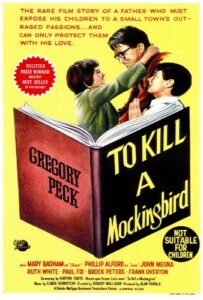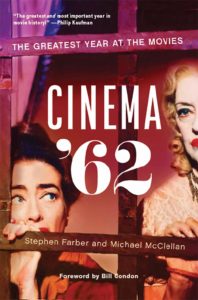From ‘Lawrence Of Arabia’ And ‘To Kill A Mockingbird’ To The Debut Of James Bond, Was 1962 The Greatest Movie Year EVER? A New Book Says Yes

By Pete Hammond
DEADLINE March 27, 2020


Looking for some good movies to keep you occupied while self-quarantining at home these days? How about watching some certified classics like Lawrence Of Arabia, To Kill A Mockingbird, The Miracle Worker, The Manchurian Candidate, Sweet Bird Of Youth, The Longest Day, Whatever Happened To Baby Jane? , The Music Man, Birdman Of Alcatraz, Dr. No (the first James Bond film), Days Of Wine And Roses, Jules And Jim, Divorce Italian Style, Lolita? I could go on and on with these films and several others which all have one thing in common. They were all released in 1962.

And now with so much time on your hands you can see for yourself why film critic Stephen Farber and veteran exhibition executive Michael McClellan are out to prove that 1962 is in hindsight – 58 years later – unquestionably the best year ever in the history of cinema. And with the publication of their new book “Cinema ’62: The Greatest Year At The Movies” they make a pretty convincing case. An amazing bunch of movies, domestically and internationally came out that year, a watershed moment in the history of cinema and perfect for streaming in dark times.

Of course talk to other film historians and 90% of them might tell you that it was actually 1939 that remains now and forever the greatest year for movies. That has always been the main school of thought when it comes to this question. Gone With The Wind, The Wizard Of Oz, Stagecoach, Mr. Smith Goes To Washington, Goodbye Mr. Chips, Wuthering Heights and so many other timeless classics came out that year. So if you are more inclined to binge ’39 have at it. But in the compelling read that is their 252 page book, Farber and McClellan beg to differ. It’s no knock on ’39 , or any other year for that matter. They just think the proper answer to the question (also posed in ads for American Graffiti) : Where were you in ’62? would be, to quote the late great critic Pauline Kael who was at the beginning of her career then, “I lost it at the movies”.
1962 incidentally was the year of the Cuban Missile Crisis that sent millions of people into their supermarkets hoarding toilet paper, canned goods, water and basically emptying shelves that October when it appeared we were on the brink of nuclear war with the Soviet Union. But, unlike our current crisis, movie theatres didn’t close, a relief for filmmakers and audiences considering the high quality of cinema that defined that year and has stood the test of time, as Farber and McClellan argue.

Actually in a foreward he wrote for this book, Oscar winning writer/director and film maven Bill Condon agrees that for decades, 1939 was the preferred choice, adding that 1999 has been gaining ground in recent years as a “credible rival”. He admits he was skeptical when asked to write the foreward. “I’ve found that a cineaste’s ‘greatest year’ more often than not lines up with the early years of his or her adolescence,” he writes, wondering if this whole book was just another case of immortalizing the thrill of first discovery. In the end though, even he thinks a powerful argument for ’62 really does emerge. He mentions from his POV the wide variety of directing giants, upcoming international auteurs, young British and American helmers, many like John Frankenheimer and Sidney Lumet coming from the early days of live television, and numerous others all colliding side by side in a seminal moment in film history.

So how did the authors collectively come to this conclusion? They met and discovered a mutual affinity for cinema circa ’62, but do acknowledge that maybe their youth had something to do with it. “It’s partly, you know, like a generational thing, and people who kind of came of age in the ’60s maybe have more of a fondness for that period in history, and you know ’39 was before we were born, so, I mean, we can look back and appreciate a number of the movies from that year, but it didn’t quite speak as personally to me, anyway, as the movies of the ’60s and it was a different, verydifferent world, ’60s and the ’30s, of course,” says Farber.
McClellan, who was 12 then, agrees but couldn’t quite appreciate many of these now-classics as a child. “I caught up with a number of those films when I was older. There were so many strong adult dramas, aside from the foreign films, which were much more daring than the American films because of the production codes and the Legion of Decency, but also these films were designed for a general audience. That’s why they had the production code. There wasn’t the rating system yet, as you know. “So, catching up with them on television, and then in film classes, and then in revival houses as an adult I realized that this collection of films was truly outstanding when you compared it to other years, including 1939,” he said.

They point out hallmarks of the year included the fact so many of the best were in black and white (anathema sadly for millennials today it seems), and in fact only two of the ten lead acting Oscar nominees were in color films, thus it might be the last hurrah of B&W followed by its ultimate decline before a little more than half the decade was out. It was also a time when there was an international explosion.
“I would say, in 1962, just the appearance of so many provocative foreign films by all the people that we now look on as the great foreign filmmakers: Fellini, Antonioni, Truffaut with Jules And Jim, Resnais, Ingmar Bergman, Vittorio De Sica, Luis Buñuel, all kinds of people who are now, I think, considered some of the greatest filmmakers of all time,” said Farber. “Some of their best movies were made in 1962, and it really had an influence on people in this country as well because they were exposed to much more provocative kinds of movies, not just sexually provocative, although there was that too. A number of these foreign films were condemned by the Catholic Legion of Decency because they really went beyond what any American movies could show at that time, but they were also intellectually daring and provocative, I mean, dealing with important timely themes that also were often told in a new way. They were not straightforward linear movies, but they played with time a lot. Movies like Last Year At Marienbad were more experimental in their approach, and all of these elements made them very stimulating to American filmmakers and American audiences.”

Additionally, more widely distributed films like Stanley Kubrick’s Lolita with its daring ad line, “How did they ever make a movie of Lolita?“, were pushing mainstream cinema towards the edge. “Lolita you know, was based on a very controversial novel, still controversial even now, and although some of the sexuality that was in the book had to be toned down for the movie, it was still very daring to deal with the sexual liaison and romantic liaison between this much-older man and young teenage girl that it was made to look explosive, and it was still translated pretty faithfully in the movie version,” said Farber. “And Sweet Bird Of Youth, another movie that I don’t believe could’ve been made even two years earlier, and again, it was somewhat compromised from the play, but it still dealt with basically the main character, Paul Newman, playing basically a male prostitute who’s being paid for his sexual favors by this older woman, a fading movie star played by Geraldine Page. That’s the kind of sort of carnal liaison that they had that even I would say in ’59 or ’60, you wouldn’t have been able to see in a movie like that. So, very much things were going through a lot of changes. A movie not that well-remembered, but in Walk On The Wild Side Barbara Stanwyck plays a madam of a house of prostitution, and she’s in love with one of the prostitutes, a female prostitute. So, she’s presented as clearly a latent lesbian, anyway.” The times , in cinema at least , were indeed a changin’.
And it also turned out to be a year when women, who once dominated Hollywood films in the 40’s and 50’s, but had fallen by the wayside in terms of what studios were making. “That’s an important point because it was a very male-oriented era. The mainstays of Hollywood were all directed at the male audience, westerns, war films, adventures, epics, male-dominated pictures. In fact, 3 of the 5 (Oscar nominated) best pictures in ’62, Lawrence Of Arabia, The Longest Day and Mutiny On The Bounty were totally male dominant,” said McClellan.

Farber adds, “’62 was kind of a peak year in that sense, with more women in leading or important roles than you were seeing in most any other year at that time, including the 1970s, which is an era that’s revered by some critics. He points out the Godfather films, The French Connection, The Deer Hunter, a lot of daring and interesting American movies but not generally strong female characters. “So, 1962 still gave you a lot of interesting roles for actresses including (the cover girls of ‘Cinema ’62) Bette Davis, Joan Crawford in Baby Jane, Geraldine Page, Angela Lansbury was in both All Fall Down and Manchurian Candidate. And The Miracle Worker was a totally female movie with Anne Bancroft and Patty Duke. Both won Academy Awards, a totally female-centered story about Helen Keller and her teacher. There was Rosalind Russell and Natalie Wood, in Gypsy, Katharine Hepburn in Long Day’s Journey Into Night, Lee Remick in Days Of Wine And Roses,” he said without ever running out of names. I would personally throw in Shirley MacLaine in Two For The Seesaw, a movie I just watched again this week. She was great in glorious black and white and it serves as an interesting counterpoint to what she did in the Oscar winning The Apartment two years earlier.

The Oscar race, particularly for Actor and Actress, had never been so crowded with potential winners, but the Best Picture race (then just five nominees) was mostly dominated by big epic roadshow movies and a major musical (The Music Man), not some of the more edgy, personal, independent black and white movies that really still hold up today. Lawrence Of Arabia deservedly won, eclipsing its biggest rival To Kill A Mockingbird (which took Best Actor for its star Gregory Peck over Lawrence’s Peter O’Toole in his first of a record 8 losing nominations). To his dying day, Kirk Douglas cites ’62’s less heralded gem Lonely Are The Brave as his favorite of all his movies, yet he was among many not nominated since there was such a crowd of contenders. A couple of now classic westerns, John Ford’s seminal The Man Who Shot Liberty Valance, and Sam Peckinpah’s now revered Ride The High Country, were all but ignored by Oscar voters but live on as movies still very viable for today. McClellen points out the latter was so poorly regarded by the heads of the studio it was shoved into the bottom half of a double bill. Little did they know. Despite the adventurous nature of films that year it is interesting to note that, just like today, moviegoers tended to flock to the more commercial offerings and the exhibitor poll of top box office stars in the book supports that by listing Doris Day, Rock Hudson, John Wayne, Elvis Presley, Jerry Lewis, Sandra Dee and Cary Grant among ’em.

As for their favorites? It seems the authors line up with the taste of Academy voters. Farber is a big proponent of Lawrence Of Arabia. McClellan argues for To Kill A Mockingbird. Both are analyzed in depth in the book. As for the most underrated or unsung movie of the year? McClellan votes for the seafaring (black and white, of course) Billy Budd, while Farber mentions the little known War Hunt (yes, also in black and white, an anti-war movie set in Korea that happened to be Robert Redford’s film debut. He co-starred with Sydney Pollack, then an actor, who would go on to direct Redford in seven movies, a relationship forged in the cinema of 1962.

Not everything was great of course and they save some of what they consider the “turkeys” for the end of the book. One that they called a “stinker” was Vincente Minnelli’s Two Weeks In Another Town, his companion piece to his Oscar winning classic The Bad And The Beautiful from a decade earlier. Both starred Kirk Douglas and were about the movie business. I loved Two Weeks In Another Town, and so did Martin Scorsese who said earlier this year he had in development as a remake. To each his own, but I am right.
So decide for yourself, no matter where you were in ’62, born or unborn, was it really the “greatest year at the movies”? And if not, what was? Check out some of these films now that you have the time. Don’t discount them because they are “old”. Remember my motto: “every movie is a new movie if you haven’t seen it”.
DEADLINE




